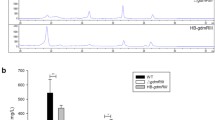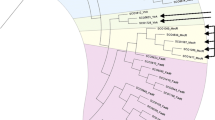Abstract
In filamentous fungi, nitrogen metabolism is repressed by GATA-type zinc finger transcription factors. Nitrogen metabolite repression has been found to affect antibiotic production, but the mechanism is still poorly understood. AcareB, encoding a homologue of fungal GATA-type regulatory protein, was cloned from Acremonium chrysogenum. Gene disruption and genetic complementation demonstrated that AcareB plays a key role in utilization of ammonium, glutamine and urea. In addition, significant reduction of cephalosporin production in the AcareB disruption mutant indicated that AcareB is important for cephalosporin production. In consistence with it, the transcriptional level of cephalosporin biosynthetic genes was significantly decreased in the AcareB disruption mutant. Electrophoretic mobility shift assay showed that AcAREB directly bound to the intergenic regions of pcbAB-pcbC, cefD1-cefD2 and cefEF-cefG. Sequence analysis showed that all the AcAREB binding sites contained the consensus GATA elements. AcareB is negatively autoregulated during cephalosporin production. Moreover, another GATA zinc-finger protein encoded by AcareA positively regulates the transcription of AcareB. However, AcareB does not regulate the transcription of AcareA. These results indicated that AcAREB plays an important role in both regulation of nitrogen metabolism and cephalosporin production in A. chrysogenum.
Similar content being viewed by others
References
Brakhage, A.A. (2012). Regulation of fungal secondary metabolism. Nat Rev Micro 11, 21–32.
Brakhage, A.A., Thön, M., Spröte, P., Scharf, D.H., Al-Abdallah, Q., Wolke, S.M., and Hortschansky, P. (2009). Aspects on evolution of fungal β-lactam biosynthesis gene clusters and recruitment of trans-acting factors. Phytochemistry 70, 1801–1811.
Conlon, H., Zadra, I., Haas, H., Arst, H.N., Jones, M.G., and Caddick, M.X. (2001). The Aspergillus nidulans GATA transcription factor gene areB encodes at least three proteins and features three classes of mutation. Mol Microbiol 40, 361–375.
Dreyer, J., Eichhorn, H., Friedlin, E., Kürnsteiner, H., and Kück, U. (2007). A homologue of the Aspergillus velvet gene regulates both cephalosporin C biosynthesis and hyphal fragmentation in Acremonium chrysogenum. Appl Environ Microbiol 73, 3412–3422.
Hu, P., Wang, Y., Zhou, J., Pan, Y., and Liu, G. (2015). AcstuA, which encodes an APSES transcription regulator, is involved in conidiation, cephalosporin biosynthesis and cell wall integrity of Acremonium chrysogenum. Fungal Genets Biol 83, 26–40.
Jekosch, K., and Kück, U. (2000). Loss of glucose repression in an Acremonium chrysogenum β-lactam producer strain and its restoration by multiple copies of the cre1 gene. Appl Microbiol Biotech 54, 556–563.
Khang, C.H., Park, S.Y., Rho, H.S., Lee, Y.H., and Kang, S. (2006). Filamentous fungi (Magnaporthe grisea and Fusarium oxysporum). Methods Mol Biol 344, 403–420.
Lee, J.H., Yoo, H.Y., Yang, X., Kim, D.S., Lee, J.H., Lee, S.K., Han, S.O., and Kim, S.W. (2017). Utilization of algal sugars and glycerol for enhanced cephalosporin C production byAcremonium chrysogenum M35. Lett Appl Microbiol 64, 66–72.
Li, J., Pan, Y., and Liu, G. (2013). Disruption of the nitrogen regulatory gene AcareA in Acremonium chrysogenum leads to reduction of cephalosporin production and repression of nitrogen metabolism. Fungal Genets Biol 61, 69–79.
Liu, Y., Zhang, W., Xie, L., Liu, H., Gong, G., Zhu, B., and Hu, Y. (2015). Acthi, a thiazole biosynthesis enzyme, is essential for thiamine biosynthesis and CPC production in Acremonium chrysogenum. Microb Cell Fact 14, 50.
Macios, M., Caddick, M.X., Weglenski, P., Scazzocchio, C., and Dzikowska, A. (2012). The GATA factors AREA and AREB together with the co-repressor NMRA, negatively regulate arginine catabolism in Aspergillus nidulans in response to nitrogen and carbon source. Fungal Genets Biol 49, 189–198.
Martin, J.F., Ullan, R.V., and Casqueiro, J. (2004). Novel genes involved in cephalosporin biosynthesis: the three-component isopenicillin N epimerase system. Adv Biochem Eng Biotechnol 88, 91–109.
Martín, J.F., Ullán, R.V., and García-Estrada, C. (2010). Regulation and compartmentalization of β-lactam biosynthesis. Microbial Biotech 3, 285–299.
Martín, J.F., Ullán, R.V., and García-Estrada, C. (2012). Role of peroxisomes in the biosynthesis and secretion of β-lactams and other secondary metabolites. J Ind Microbiol Biotechnol 39, 367–382.
Michielse, C.B., Pfannmüller, A., Macios, M., Rengers, P., Dzikowska, A., and Tudzynski, B. (2014). The interplay between the GATA transcription factors AreA, the global nitrogen regulator and AreB in Fusarium fujikuroi. Mol Microbiol 91, 472–493.
Niehaus, E.M., Kleigrewe, K., Wiemann, P., Studt, L., Sieber, C.M.K., Connolly, L.R., Freitag, M., Güldener, U., Tudzynski, B., and Humpf, H.U. (2013). Genetic manipulation of the Fusarium fujikuroi fusarin gene cluster yields insight into the complex regulation and fusarin biosynthetic pathway. Chem Biol 20, 1055–1066.
Ullán, R.V., Godio, R.P., Teijeira, F., Vaca, I., García-Estrada, C., Feltrer, R., Kosalkova, K., and Martín, J.F. (2008). RNA-silencing in Penicillium chrysogenum and Acremonium chrysogenum: Validation studies using β-lactam genes expression. J Microbiol Methods 75, 209–218.
Wang, H., Pan, Y., Hu, P., Zhu, Y., Li, J., Jiang, X., and Liu, G. (2014). The autophagy-related gene Acatg1 is involved in conidiation and cephalosporin production in Acremonium chrysogenum. Fungal Genets Biol 69, 65–74.
Wiemann, P., and Tudzynski, B. (2013). The nitrogen regulation network and its impact on secondary metabolism and pathogenicity. In: Brown D.W., and Proctor R.H, ed. Fusarium: Genomics, Molecular and Cellular Biology. (Norwich, UK: Caister Academic Press).
Wong, K.H., Hynes, M.J., Todd, R.B., and Davis, M.A. (2009). Deletion and overexpression of the Aspergillus nidulans GATA factor AreB reveals unexpected pleiotropy. Microbiology 155, 3868–3880.
Yin, W., and Keller, N.P. (2011). Transcriptional regulatory elements in fungal secondary metabolism. J Microbiol 49, 329–339.
Yu, L., Li, S., Gao, W., Pan, Y., Tan, H., and Liu, G. (2015). Regulation of myo-inositol catabolism by a GntR-type repressor SCO6974 in Streptomyces coelicolor. Appl Microbiol Biotechnol 99, 3141–3153.
Acknowledgements
We are grateful to Prof. Juan F. Martín (Universidad de León, Spain) for providing the plasmid pJL43-RNAi. We thank Prof. Xingzhong Liu (Institute of Microbiology, Chinese Academy of Sciences) and Prof. Seogchan Kang (Penn State University, USA) for providing the pAg1-H3 plasmid. This work was supported by the National Natural Science Foundation of China (31670091 and 31470177).
Author information
Authors and Affiliations
Corresponding author
Rights and permissions
About this article
Cite this article
Guan, F., Pan, Y., Li, J. et al. A GATA-type transcription factor AcAREB for nitrogen metabolism is involved in regulation of cephalosporin biosynthesis in Acremonium chrysogenum . Sci. China Life Sci. 60, 958–967 (2017). https://doi.org/10.1007/s11427-017-9118-9
Received:
Accepted:
Published:
Issue Date:
DOI: https://doi.org/10.1007/s11427-017-9118-9




